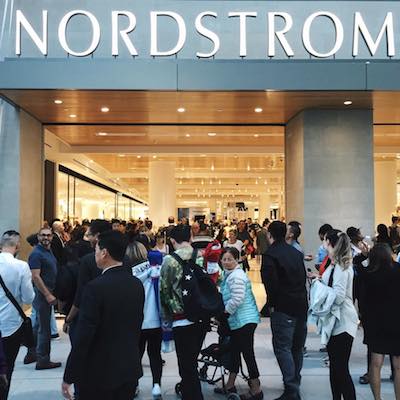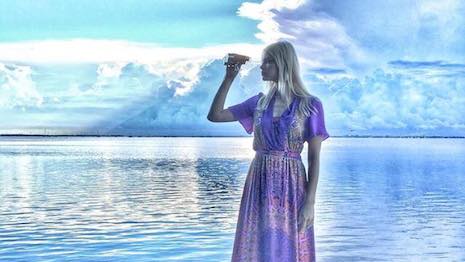NEW YORK – Across all regions, luxury ecommerce is growing at a faster rate than total sales, according to a senior analyst from Euromonitor International speaking at Luxury Interactive 2016 on Oct. 19.
Speaking on “Divergence in the Digital Landscape,” Ayako Homma noted that while the entire luxury market is expected to see a compound annual growth rate of 2 percent through 2021, luxury online sales are expected to rise at a CAGR of 7 percent in the same timeframe. To capture this growing piece of the luxury pie, brands will need to improve their omnichannel, ecommerce and mobile experiences.
Mixed market
In 2016, the luxury goods market is worth $300 billion. The minimal growth that is happening is inconsistent.
Markets like Canada, Mexico, South Korea and Japan performing well, as consumers stayed home to buy rather than traveling to the United States. Canada in particular benefited from department store openings.

Nordstrom store opening in Toronto
Brazil, Russia, Hong Kong and China are seeing decreasing consumer confidence, leading to faltering luxury sales. The U.S.’ strong dollar, declining tourism and discounting in department stores have combined to hurt its growth.
The online luxury market, on the other hand, is valued at $28 billion, representing 9 percent of total sales.
This is only expected to continue to grow as more consumers get online, as today only 42 percent of the global population has Internet access.
Mobile Internet access is also expected to rise. About half of phones subscribe to Internet access today, with an anticipated 84 percent connected by 2021.

Image courtesy of Bloomingdale's
In the past few years, social media has also become a place of transaction, particularly for emerging markets. A survey taken in 2014 showed that China, India and Mexico have the highest percentage of consumers who had made a purchase through a social network.
With the addition of buy buttons on platforms such as Pinterest, the population who buy via social media is expected to increase.
Beyond the rise of digital channels acting alone, another trend is the rise in omnichannel retail.
This might mean bringing a touch of digital in-store, as Burberry has done with its smart fitting rooms. The magic mirrors recognize the apparel the shopper has brought in with them by tags, and will play a film about how the garment was made.
The physical and digital are also cross over, as brands operating strictly in one channel or another are branching out. Tiffany launched its first collection with a multibrand online retailer this year, partnering with Net-A-Porter, while ecommerce startup label Bonobos launched upwards of 20 bricks-and-mortar “guideshops” in 2015.

Burberry's Regent Street flagship
Seven percent of personal luxury goods sales are made via ecommerce today, but online retail will represent 12 percent of the luxury market by 2020, according to projections from the Boston Consulting Group.
About six out of every 10 luxury purchases currently are influenced by digital channels, as social media, a brand’s Web site and mobile feed into buying decisions, whether the transaction is completed online or in-store. While many luxury brands have been avoiding the shift toward digital that many of their mass counterparts have made, BCG warns that the business models of digital laggards will no longer suffice in today’s market (see story).
{"ct":"Tjm5yIS48HymQHd1Td8\/YMO0Fo8gUQy2zK5Qqaw58oBUGC09z7coqrnJ8XhdPHI9cVtQ59RpZYGYVnejfTdtqCtYrJek2gCszUuazDvCNSrtzHKVcI0I4b6ZJ\/+DbNaFtjxbuGzfL3TOwjDzGwNPIbO0sYZJln5quIBDWXmsXecvJJe8ZFaufZ7DesrggpxYcr9QRjoubUnBt8VbcoOvcI7J2lhFf4BQRa+q1GgT58C1MV5C4z50q17Dr\/1X6ksED1DfDx6GXcDPjjhoo3EdQehbepvXUAy5g5UzH8gK8hMACOqt+q5A7CHmJrAXx\/uVwWPEeutQrepPhZNmySas+4qvHdXtjNkyC8\/vd6N3zcWBABVeCQvb4\/vfiZq++Idw+eax2u2rIYr7ZsIqmnf08KSnraZXA3XLFu5FPrv\/KGEPg+xdVXG5ThuYjFcGwvK4MxghmXuhNk8fp6cLlNwHmVs9Mnv7yXrWySMR78mpH8Xx0\/D58xT5GXUqsoXeUUL2Aujr2zN36eu0RC8Cpv5i7XNJo7laydm7PbCFvl48zXADBBBjWyM02z2FAHx5Fb4wz\/QpdlznPSlc5ng3\/mPr5nygvXvk+nuzfRKKzZeZcSGJTYIc0s3lTgtZfqaQyqZ2M22VxRviiC+6jKG5hA4Dd+X9eC7RMBJupmDzf6PkK44DNP2t99wGY2lLG2cXUOBZ+lo5ovCtSaeRWjWSGNzC5KIvftT455LbJsCM8\/1jzNiu6CStICTfbBqKY\/8LG5IFBPLcQAY+QIXbBBVnP2rAT815cBvQZ14oRgZQ0G\/27g+Iaa0WNNhwCkO732tUSxmzP3KUXZb2b4LTxeHLLfKLjWaSfaNzchjq9fus6Hhgyij1D\/4BbR09\/CmZKAyd\/PGl8SJZKmFD0lXNgMSp2z+lsQ6nHbb+ZFxkgeLRYRrxAd+f6wFY9wAYFyPKN36ngKk9AjgstnCQ2i2152c2EwT5vjfQE6LYJTtOXHNieFt\/YhChorMSuKRUeLW1O50sM6\/IaF9HqGEK0N\/1o2inMDzK2Nz7ZgX5DYqP+20PiRDCQgmfumPc5u4mq2Kg9fJmOmi6lAdKOBsIA6S0auNUNcYpfMPzqCRJNYeQYsq4qYVIKCkbwJznAJhwQ4xO9OeTAosocrq1wWtiNslcVlZcbzM+42bH761L86GJh\/kLTVWzVRq\/EAbR3WKc9xT5QHcFJvd5T1o6mzXDV2eBsUC3Zxn0quh0bHjDuKjOgnBj\/Q4ye7XiHL1ZMNM\/tAiLXjGp4p9bc7NJMN0CwHMGK26DKbkelFKLlbECniBSCxgBR201v5ty02pRhkVN3kUB21mLCJ6Pd2hIOjylpK3iL+Fx3eDPkofuWQTLBumavR4IXWfPtkPrOtpHJl0J0BPFKZOlcyGCBgyqWEvFR\/K5dwmXkP1ebBgpukdhmzQzZq98EcSCnedxhzpy6j8MbdbrZrk2nj+v6B2uS2zPuf7iFsyJm6TVpo+eCcwGqc4HrVZuQHvP5Dd5tIGr5yvXy74l7KSAlLCBVhSsH8o1tcw5vmPnlaYsKPKZZhBMdBPTk++Y3CmoRK0G5z0n78WLkAOhvnHbkaiPwTUefpggEwVttXdVwDUJACbie3Q1dEofoEM0COhzGpteHzE3+nTA8HbAH7JX5dYhtjl6oSmeksspatH0q2BGujEUSjZDSsjmB2qQBmnmVjyFvEaLpi76slRPLjVYJxjTFFfdirXTOIk8g5139Wwq+Vw5OcFNUtgodbXiUSG1zl4kysHfpM0R4XCESB0tsQpcipK31hSa9ooQUEjHDQM2a4vvK2mdJhuOPipk8YHU8xDREkDB5GjTKT4rGaGsJr3nVRWu0uKSAAU9pxepEiQbsN9MlpHH81XR3py0A65Yaslc97CfX3HHvfzMVygN3ayogKg2NB5Orke91vCwpM6d25SfmLM8BPW4+LGK5xfRuIeX0i2gFAOSLZ9mh3MehGWX9s+c3vsQKOIBhGRRugKIlnFPwX4fduL8tSP5q7zImOKgKBpuXielfnlZa+PhzuQEJSH0NMLViqPxURGofgkpro9FKw7uA\/xdviYVM71mrTgQ0BTw9OrZ0xFojtifS4uSwurUza6JJ\/Qd1+bIMsWIS7iHXlTzxXHNJ8P5tIHGu18ggzXNJlIvpzhCZJaici6WjOSAz\/IcoqTVdW4tZ13pkrYEXK9+SV63h\/UIB85l\/wZsR5alD1ofC1qowH7gcVvkm3bBE7CUJGxou5nzHKJ2iZ7hTQXWe8KIU07vCMy8gGq4TpEH47z4EzDMg2MqfFPMrxfUCyRB2b+NeJq7TZ6uKwGUXbMhE+9jMI5LJHhASwDkb2cnDEeQINGPAKWHwGH4THU3OHELBsBskwuDQc5Uso39IK0MH9RAax16tGPmapDo2UjwxsMlRi9AUakiL3slBzA9WOd2nTMlPENFBqHsh\/A2EZIGiIliQ24tPzJbJjrq5FQtzosyiR2GYJ26Zdvj\/73IN\/fz6mXV\/K+Sao\/NlWwT\/GCxm1Bw93E9q+UqJOttTLuhyn7jJFll01KmOWwIMGCSVOu1NAmtg95O0huo0a4NrGYfM5xGn3YXagUDgENhtZMyV7L4vAHtcUX70exQHWx7LnYlvi7ARR2CYHQ9BEYV4yf4k3Q8xrcFpoJqLW\/VUGRX\/GU\/shb0\/6L1wPlY612aaAp\/HLKnBzxOQLpVBRUfCjR8tv8ISWCc4DoEIxVb9rnhT03voFE6NRoKxLOZ+fblWmt1vdX\/tlTEP\/2\/f6uhqtN3nfsyjSXNh7Y20CyQEDvOsbkN8zY8Cw8D18STU4hRZ+wq7xHyfqCCukQjvSdtToqhYbANI1SKNL6DM\/QsP\/Nk8jsYIOixs1+nsIcbNX\/RrUeuyz6e0C9A88h21ehmUxDd9blUyv\/xTLX0OsYkqHLisBlPIwEfgXRq6YrZH7TOiy6ftzCjxtcjBxvH2Y5\/2jSBpL16TuVqxorUl9TwEDq6a\/0I\/ZrTjVfaq5L6ttOB9FR3Z1Dx\/6wRwe4By55QejWK5129rb6ua6UlyMYJlFoo9NUqOLRi83nBLOOf5XGbVitFO5Cog0nF9BKjEMclstTaXFl\/KO5A1KGCjrhK0MdwAXDV18hqneGuHAIp0DQGP7ONNbn9TuylmOkLdNnAI1C\/A9ZHxWeFP+M1w8f+xPMqXGQCmKg\/GzDT65Ju4lNl\/o\/gM8M3bSTI8QdwfmIjLn+I3PkliaGdvDxalULjcwsT2mx1hl3hA3Duf4pn8WraOvx4k0ruDhaZH2I0eweuTGtfVAnigzyD0ix1EFvWExK\/zSmlaoKWgvzoz+kZGX2Jo6r58w5SHN3c7R5dnzgqCUmFIwCAVOo5cGlpvwnViRxq03eQ8+2vyhL3JU93LWjiLHyzKb+qSfGeACxOigyvYaPTKkXZdC4IxgqIy0a5Eqsp\/s5c6DLbhqmTebvgSleyixaMIXg\/ynNlYWdG4TEFNtJ8wOzUxJQuVE2nDUKUnYwPEseNo2abjYWfFh8a12DCfAbfjH3p9bFXXE9zWOm3J5pbvcXwobZSC84vQCDPfkZR+BhUKl0R3daZ782Ey1E+tqWKqkdVkn0XoiPK7ZgUqtzdi3yRKPEN6BRVTZCA\/ZlPrNCDfvrIpNyv2CCNuUK+\/w1orCk3tkYn5jzMYHm\/hLdvZc2swQPZ0ban+fnyd9IJIm8OMjl3sVuHxQaLl9XvcSKmvKm3gxAL7PLWrmFdTWDduNAnZ+GhuGwAxNpfgs8XEnMvs2GxBxehX8o+kg8fz3XvZZ3O6wKVrA3Eh8\/wNZGRIsMIvZ245E2\/Pr+O\/c136Mvt0Giuhwh9ITVMx08knaiyyDuJPhHTJ+9jPxWsDG2KCtsMOQO+L21QP54DCW5QRej7wCaksfJEfeCx2oTJLuK\/6ROiupgIiG469NX6o58MdaxT8Ef\/LXNQCh6bCPdJ5C6guckw0nHMWUgZfuzK69NyqQBFzR09iwg9DAsQctjFmENhJYLT6+RytNtcYr0oHotVrriigj4lwcSgiRpUEzVbNbgbhsUarLiRWkkhyXmppOOnufTxj\/JYQFYoy4WEnOWkt14ytLVZgvr1e5LhV+909Ox5ObZpsxFOg7YM7dJI5WMAaL9DEFiu1vWdFnw\/PZ6uxICnIacLE3+c6WgP1+aDEorPHqrOh1PnMDxeCBTFUdv4TG871kWWGKFQJVojMT4weSA1Xk1wMawEWfqxIhsqjqhFT5ymBhqXYfJREXF\/LwGzf7jTQ3Ya67pAd08QXwylqy8Tsb6slMmrcJ3mRFhcRyLPq0nK1nP67A7bTo8iwOSIk+6E3ORabLkMRpxxLnmog8fqyO2GOJCHU7TLoCNZOAbt2+GHktd7bCCxRxFkjEdJ67BbBvfIn4jXn\/93dtolSBPhvmtk\/jWrJAmAgrXRwqXY4RyXJkToZ5N775icJ\/wHBlRZoSOFkiX2duZb4RSyw8BOSibi8Ajjh3JSOlVgxdzpxNJP3GkA9CBelopZAA6vskjJOk4wntYw5w56nwep8IOQGNDGGfoHpgirBdCuRlH\/JzrOl+rSAMUYxoVDUXFgXAdz+\/MyKFps3zY9GRmr81whG9fNTXQiZSWZyWufJ6qsCtviM6SkoaMZoOP5CNTPjtqpTJvYkMuBp+ngzftvmP3Rpo42DBjbfp2V6RpTtsPvt0XadpwkdL1uEQw6DRC7iCCxVBXAjUUNlSkKGIXsK6GfRcNQDotsMlJPSeAuC34hTSEI+865t4\/zYxORj8CAr2uEYVBXnxQ2LNJPw+9KowrOXY3zfXXtNTEQnvHDzNabwJ2j4BJKXEblkpDUKRR56xILyYN\/t40PnRVhtfNCbl41PRULtAvEwQKd6XwxcbQ3beKq1Oliy9VLsPB2aCcTjls\/y6YSPjlXy1f6JBgzGG1RO0NgqlFe0jc5is55SipMDLKdemPt1zSoBKXUzfoo6Af5\/hmYei31RXcGD+GVcGo1vDPPtkEOM1hACUsq0OQvCRbWj0CaNiSPWHs5y2kF6R8xukW2iOv0QBk9aRXBZQI+REgK7Q2Yp8rC0oLQoxB6qE7h4cLqeOzPIwono3oXpY\/BHE6tMtrm2vtQF12vVYDxTMj2lbbv5MxiNciyWA8QjFMNAG77HajIYnXH17+KxuOr3PD9pIUTsh6Yfhjf8S6WpKl\/soEM3vat8tZUfRgM3FzCr7M8hPobsDH3PDyWQ8DN3ikYUUYUeMsMvWDxsNyk4UnSeciMSQauJXtyTZfk54z\/mgO9R95viUWNh\/g3OGMrZLriZpEGF2n+2mGLYK1CckfOHZIdKkWre7M\/wbPQx3d+uJ6tWWDmkkaywnzqcDqcdlolVyjkNVpq19ODlTyfILE+rTZle379RHKUvloDJb+2+am9X+YOJ3hyLP0\/luKV8DWq4KZls27kD+xh4GVkgf2pUeTMvGE7N84nXlENewWqMnNE76q1uKbvrQru6HJ8P72UobmOQpBH\/qDZemni6V1LEG4zCTQu5h6eOXTPhQ2u\/iVgCi\/Qim4Wia3DfcR0L0KLvXegTZfILPBXlKQ6MnJBl4X4pOJ\/gwA1lvi6r5crNUOqrTD6Bcj4AFFm8JfxEmfoL8Fux5KqofoO8WQyKARlcVmuiP66oPt\/pWab5U80LqBE8Uxgt6qEWmh6yVJVi7sVvKO6tZg3Wc\/IR6u879EcaMi8Z\/9fTNS\/4QK9B\/MjtkAi+QeDruQyPIlxSeva5Tb55D9Ca7pa6S0JkLnB3zUKMRrEio7l\/s2Qvz62aMJ8aFQsChtzSHTnAGgiJ2H8W8vnIqj5Tq46lT1c1HYepeapDZt06GZM000VYOdkqYiUczOYKX7sTFxwD0LRiTlWkXn2Sm3aVfan\/tyWWPC7EvJtlx+udxzMZmxSOAXn1sdMfIgfaiP9OKUvlkDHMY6QKpOcv33DI8YEA9tNUnegCwEYIqSa3ke1xrlE9IyxyUyU6O62kH+XEVZ4l+qr0nH3cwoGxv\/2\/9gl+N5Whha3yZsYuQ8DOXtYyH54oGeI\/e8vl0QmFTlTHkDPcIS8Vrt4l+cPWWd+7VXnr9OA712y2JgxMMzl65BCGJfkUJ6Xp\/cFzHvEsQ7yKW4fQd0n9Ox0FGudKSa5mzcxZL472nsNJBdNmTNRwpjY\/sZr8Zko1lEQ+moxkIrqh4jx6UnDNPnMuN\/7GewGq+LtC2bwuoGM1j4vjMSEGJCPTRhDUPEizmq3tMFO8O5b29wgK2oE9qyzG6v2d7zDbT4BJqdSeFNHucyiQon+yYjm2gmy2W3kgHlEghlObiEvVKs59kvgag7OP7HGouA+pxJxyyEP0QSQGEmeVMK33Wc+fhJZ82eMe6VyWTqLlv9IFi4PROY9b1g04S5DdhwNaB8bQwtHMQe58wc9BzZ8YZPEIhc8hRxlxmu\/+tR9UHdWs961OdrxkuaJiE4AWbD2cKg685pfNYkL4Mpisbzl2dFax1MiPkq0B\/8SeSOEgO\/ZjyTuDYh8jsSLp60W7GJfsQRJ69D3YGXw\/gHxVPfcPnU5UmRjNlQDD8Lm4LVZTQ==","iv":"d459b6e7d8df3f72707c0b47866c74a4","s":"3dc9b35a5675bfd2"}

 Image courtesy of Aventura Mall
Image courtesy of Aventura Mall